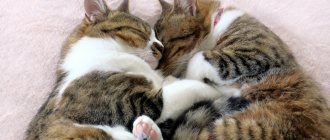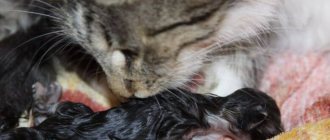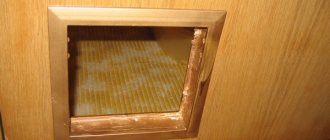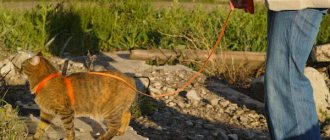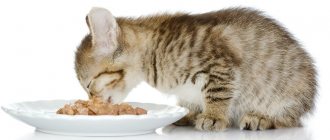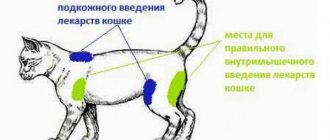When do kittens start moulting?
Cats start shedding early. At about the age of six months, kittens begin to gradually change not only the structure, but the color of their fur. The duration of the first moult varies. Sometimes at least 6 months. During this time, the kitten sheds baby fluff, growing dense guard hairs. In point and multi-colored cats, the markings appear brighter. The appearance becomes complete.
You need to combat molting in a comprehensive manner. To begin with, support the kittens with vitamins and enhanced nutrition. In addition, this is a good opportunity to accustom your pet to hygiene procedures: combing and bathing. And simply smoothing your fur coat with a damp hand will not only be pleasant, but also useful.
Don't miss this moment: how well you take care of your kitten will determine the appearance of an adult cat in the future.
Why and how cats shed
Subsequently, molting will become regular. For cats, this is a natural process of preparing for the change of season. Ideally, a cat sheds twice a year:
- before the cold weather begins. Reducing daylight hours and a significant decrease in temperatures include protective mechanisms that involve a change in wardrobe. Cats are rapidly growing a new coat that can protect them from frost. For example, the British grow a powerful, dense undercoat, which is much thicker than the summer one;
- before the onset of heat. Rising temperatures make it necessary to prepare for the summer heat. “Winter” fur, having served its purpose, is no longer needed. Therefore, a lightweight version is growing.
Cats that have free range react most strongly to the change of seasons. Their bodies are exposed to natural weather conditions and are sensitive to the changing seasons.
Cats living in an apartment without walking, despite the lack of seasonality in the home climate, also shed. Only the time of this process is not strictly tied to the environment. Depending on the breed, cats shed 1-2 times a year.
It should be borne in mind that in mature, uncastrated cats, shedding can begin at any time as a reaction to certain changes in physiology. This is how the body will react to hormonal changes during estrus or after kittens are weaned from mother's milk. This is not a reason to panic, you just need to provide your cat with improved nutrition and vitamins.
Molting as a consequence of the disease
Hair loss is accompanied by a wide range of diseases, so one fact of increased shedding cannot make an unambiguous diagnosis. You should be concerned if the pet's fur does not recover, and in its place pink bald spots appear, which the pet diligently combs. A veterinarian is also required when a constant change of coat is accompanied by changes in the pet’s behavior.
If the fallen fur is not replaced by new hair, you need to take your pet to the veterinarian.
Causes and methods of control
Excessive hair loss in cats is typical for diseases that somehow affect the skin. Less often we talk about global pathologies that affect the entire body as a whole.
Table 1. Diseases leading to hair loss
| Pathology | Description |
| Fungal skin lesions | The first sign of fungus is the appearance of bald spots, which itch and give the cat no rest. If left untreated, the fungus progresses, bald spots increase in size and turn into foci of inflammation. Scales and dark crusts form on the affected areas due to constant scratching. The disease requires a mandatory visit to the veterinarian and a course of treatment. During the recovery period, it is necessary to limit contact with animals, since the fungus is contagious. |
| Seborrheic dermatitis | Some cats have a hereditary predisposition to seborrhea, others develop it as a result of parasite infection or hormonal imbalance. Hair loss is observed only with oily seborrhea, due to which itchy scales appear on the cat’s body, falling out as a result of constant exposure to claws. Along with the affected areas of the skin, hair also falls out. Treatment of the disease depends on its prerequisites - antibiotics, antiparasitic drugs or antifungal drugs |
| Demodicosis | The culprit of the disease is the subcutaneous mite Demodex cati, which causes a violent reaction in the body. Demodectic mange begins with damage to the animal's face - redness appears around the eyes, mouth and ears. In the absence of treatment, the mites spread to the rest of the body, covering the body of the animal with small tubercles containing pus. It is interesting that a certain number of such mites are contained in the body of every animal, but only with weakened immunity their activity becomes obvious |
| Hypothyroidism | The disease is quite rare and consists of dysfunction of the thyroid gland, as a result of which thyroid hormones are not produced in sufficient quantities. Hypothyroidism also occurs in a congenital form - kittens are born with no fur or completely lose it in the first months. In addition to hair loss, hypothyroidism has such unpleasant manifestations as decreased temperature, weakness, apathy, and prolonged constipation. As a treatment for hypothyroidism, radioactive iodine is prescribed or surgery is performed if a tumor is detected. |
| Atopic dermatitis | This type of dermatitis is a manifestation of an animal’s allergic reaction to some environmental factor. Atopic dermatitis is accompanied by severe itching, forcing the cat to literally tear out tufts of hair along with its skin, after which wounds of varying degrees of depth remain on its body. As a result of such activity, the animal's body becomes covered with bald spots. If the source of the allergy cannot be identified, the pet is prescribed broad-spectrum antibiotics and/or antihistamines depending on the severity of the condition. |
How long does seasonal molting last?
If you are scared by your kitten's long first molt, don't worry. This is due to complex processes of physiological maturation. Shedding in cats that can be called adults goes back to normal. On average it lasts a couple of months a year. Once in the spring, and again at the end of autumn. There may be minor time shifts in the schedule.
Usually short-haired pets fit into the schedule and timing of shedding. It’s more difficult with the fluffier ones. Persians or Maine Coons, after shedding their guard hairs, take a long time to get rid of the undercoat. They definitely won't be able to do it without your help. If you don't help them with their struggle, the consequences can be serious. From local tangles to completely matted fur.
Sometimes shedding in cats occurs unplanned or does not stop for a long time.
Short-haired and long-haired
For a person who suffers from allergies or does not have the opportunity to often care for cat hair, an important condition for choosing a pet is seasonal shedding. Do not choose a cat with long hair and lush undercoat. The hairs of the cat's undercoat come out more abundantly than the guard hairs and settle on furniture and clothes. The optimal breed for an allergy sufferer is one with short hair and little undercoat or hairless.
Cats that shed frequently
Let's list which cat breeds have the most severe process of hair loss:
- British and Scottish cats shed all year round;
- Maine Coons, Siberian cats, and other long-haired breeds - they are characterized not only by seasonal shedding, but also by less intense hair loss throughout the year;
- Angoras, Somalis, Burmese, American Curls are also long-haired, but little hair falls out, long hairs are easily removed from furniture.
Cats that don't shed
Breeds of non-shedding cats that you don’t have to fuss with:
- Siamese, Oriental, Abyssinian, Bengal, Singaporean - these cats have no or short undercoat, so shedding takes place in a short time, and much less hair falls out;
- Sphynx cats;
- curly cats - laperm, rex.
Reasons for intense year-round shedding
Considering that shedding in cats is a natural physiological process, it is important to understand when it goes beyond the normal. If fur falls out intensively for more than a month, especially out of season, and without objective prerequisites, this is a reason to think about the reasons for what is happening.
Usually a cat sheds a lot:
- During illness. It doesn't matter if there is an internal disease or the cause is on the surface of the body, shedding in cats is an indicator of health. In normal condition, fluff does not fly in different directions. Moreover, you can suspect anything: from banal vitamin deficiency or allergies to serious diseases of internal organs. Only specialists will carry out competent diagnostics. You should not self-medicate, as you will only make the problems worse.
- Unsuitable care products. If health is not suspicious: tests are normal, behavior is active, and shedding does not stop, this is a reason to change the shampoo, at a minimum. Ideally, change all cosmetics for the cat. You may be using the wrong brush. Pay attention to what accessories are recommended by breeders and veterinarians for each specific breed separately for everyday care and for the molting period.
- Errors in feeding. Often the reasons for year-round molting are in the food. Natural food must be prepared according to special recipes that provide an ideal balance of nutrients. Be sure to supplement with vitamin supplements a couple of times a year. Ready-made food, even the most expensive and high-quality, is also not a guarantee of peace of mind. One ingredient that is individually unacceptable to your cat and shedding is guaranteed all year round. Choose carefully. Preferably, with control through analysis.
- Stress. Among cats there are phlegmatic cats that hardly react to changes in the external environment. But there are cats for whom even your daily trips to work become the real end of the world. Jealousy, lack of attention, loud noises, unfamiliar smells - this world is fraught with many dangers and possible causes for stress for cats. If diseases are excluded, feeding and accessories are checked to the smallest detail, go to the veterinarian for a sedative.
Sometimes a cat sheds heavily in winter, especially if it constantly lives within four walls. Among the reasons: dry air and too high a temperature. How to fight? Humidifiers. Open containers of water that evaporate moisture help a lot. For example, an aquarium. Again, fun for the cat.
How does estrus proceed?
Estrus is manifested by a whole complex of behavioral reactions. The most striking signal of its beginning is the calling cry of the female, with which she tries to attract the male. However, estrus is not limited to just the external manifestation of sexual heat. This is a complex process that takes place in several stages, which is controlled at the hormonal level.
Periods of the estrous cycle
The estrus process in cats is divided into four stages. Each of them lasts a certain time and has its own distinctive features:
- Proestrus. This is the first stage, which lasts up to 4 days. Proestrus is characterized by restlessness. The pet rubs against interior items, becomes more affectionate, obsessively demands that the owner stroke it, and makes quiet sounds.
- Estrus. The duration of this stage is about 10 days. Estrus is indicated by louder meows. The female actively seeks a male for mating; when stroking, she presses herself to the floor, tucks her hind legs and extends her tail. If it is necessary for a female to become pregnant, she is brought together with a cat at this time.
- Metestrus. During this period, the cat's sex drive decreases. If fertilization has occurred, then she becomes indifferent to males, and sometimes even shows aggression towards them. The duration of metestrus is from 3 to 12 days.
- Anestrus. The last stage of estrus. The sexual hunt ends, the pet's behavior becomes the same.
Signs of estrus
When a female walks, you can notice this by characteristic signs. They manifest themselves most clearly in the second stage of estrus. However, the beginning of the process of sexual hunting can also be determined by some changes:
- the pet often visits the tray;
- there is a change in mood, an affectionate cat may suddenly become aggressive;
- appetite decreases and sometimes disappears completely;
- vaginal discharge appears.
High levels of hormones affect the behavior of the female. During the active phase of estrus, the following symptoms can be observed:
- Obsessive affection. The pet literally does not leave the owner, constantly rubs against his legs, and demands attention.
- Mating positions. At any touch, the cat takes a pose indicating its readiness to mate. She bends and lifts her hindquarters, extending her tail.
- Screams. Luring the cat, the female screams loudly. Screams during sexual hunting cannot be confused with anything.
- The desire to get out of the house. Following the sexual instinct, the animal strives to go outside the apartment to find a partner.
Duration of estrus in cats
The active period of estrus usually lasts from 5 to 10 days. The duration of the process depends on age, breed, season, health and living conditions. The first heat may be faster. In adult cats, hormonal levels change, which is why estrus lasts longer.
If the owner carefully observes his pet, he can accurately determine how many days the estrus lasted. In the future, the duration will remain the same. This information is necessary for breeders who breed purebred animals.
Prolonged estrus may be a sign of ovarian disease, cyst formation or tumor. An ultrasound scan at a veterinary clinic will help clarify the diagnosis and identify the problem.
Heat frequency
The average frequency of estrus in cats is from 2 to 4 times a year. The frequency of ovulation is influenced by physiology, genetics and the presence of previous pregnancies. Typically, females who have given birth walk less often. They go into heat once every 3-4 months, sometimes once every six months. After childbirth, sexual desire resumes in about a month. Cats that have not given birth ask for a cat every month. With age, the frequency of estrus decreases, it occurs faster, and the symptoms become less pronounced.
Methods for reducing fur during shedding
When a cat sheds, you will need a whole arsenal of tools to fight it:
- Complete balanced nutrition.
- Supplements and vitamins. Particular emphasis on amino acids. Along with veterinary supplements, you can give an egg yolk and be sure to leave the sprouted grass. For long-haired dogs, it makes sense to buy a paste to remove lumps from the digestive system.
- Give the cat a bath. With water and subsequent combing, the lion's share of dead hairs is eliminated.
- Combing. Cats with short fur without a lot of undercoat will get by with a regular brush a couple of times a week. For furry cats or cats with thick undercoat, you may have to resort to a furminator.
